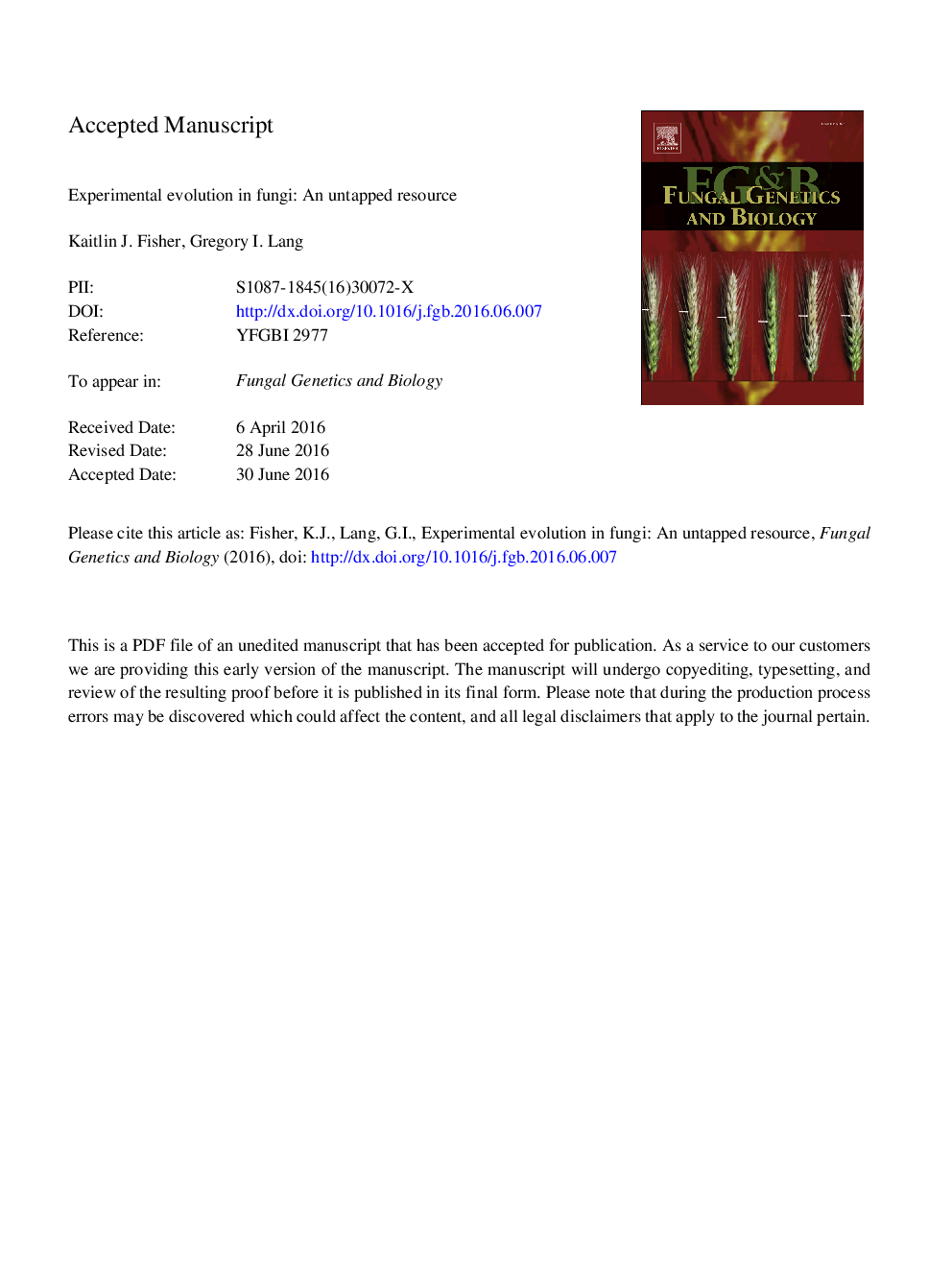| کد مقاله | کد نشریه | سال انتشار | مقاله انگلیسی | نسخه تمام متن |
|---|---|---|---|---|
| 8470481 | 1549997 | 2016 | 19 صفحه PDF | دانلود رایگان |
عنوان انگلیسی مقاله ISI
Experimental evolution in fungi: An untapped resource
ترجمه فارسی عنوان
تکامل تجربی در قارچ: یک منبع بی استفاده
دانلود مقاله + سفارش ترجمه
دانلود مقاله ISI انگلیسی
رایگان برای ایرانیان
کلمات کلیدی
تکامل تجربی، قارچ، ژنومیک تکاملی،
ترجمه چکیده
از لحاظ تاریخی، زیست شناسی تکاملی به عنوان یک علم مشاهیر شناخته شده است. بررسی جمعیت ها و به دست آوردن تاریخ تکاملی نظریه های تکاملی قالب. در مقابل، آزمایشات تکاملی آزمایشگاهی از سازگاری ارگانیسم های مدل سنتی برای بررسی فرآیندهای اساسی که موجب تکامل در زمان واقعی در محیط ساده، اما کنترل شده می شوند استفاده می کنند. با پیشرفت زیست شناسی با توان بالا و توالی نسل بعدی، اکنون می توان صدها جمعیت موازی را به بیش از هزاران نسل رسانید و دقیقا فرکانس جهش های مختلف را در طول زمان محاسبه نمود. تکامل تجربی ترکیبی از توانایی همزمان نظارت بر جمعیت تکرار با قدرت برای تغییر پارامترهای مختلف برای آزمون فرضیه های تکاملی خاص است، چیزی که در جمعیت طبیعی غیر عملی یا نامطلوب است. در حال حاضر بسیاری از آزمایشگاهها آزمایشهای تکاملی آزمایشگاهی را در تقریبا تمام سیستمهای مدل شامل ویروسها، باکتریها، مخمرها، نماتدها و مگسهای میوه انجام میدهند. در میان این سیستم ها، قارچ ها دارای یک طاقچه منحصر به فرد هستند: با زمان نسل کوتاه، ژنوم های جمع و جور کوچک، و دوره های جنسی، قارچ ها یک منبع بسیار ارزشمند و به طور گسترده ای برای استفاده از رشد آینده در زمینه تکامل آزمایشی هستند. در اینجا، وضعیت فعلی تکامل آزمایش های قارچی را شرح می دهیم و به همین دلیل قارچ ها به طور منحصر به فرد برای پاسخگویی به بسیاری از سوالات برجسته در این زمینه، مورد استفاده قرار می گیرند. ما همچنین بررسی می کنیم که گونه های قارچی برای تکامل آزمایشی مناسب هستند.
موضوعات مرتبط
علوم زیستی و بیوفناوری
بیوشیمی، ژنتیک و زیست شناسی مولکولی
بیولوژی سلول
چکیده انگلیسی
Historically, evolutionary biology has been considered an observational science. Examining populations and inferring evolutionary histories mold evolutionary theories. In contrast, laboratory evolution experiments make use of the amenability of traditional model organisms to study fundamental processes underlying evolution in real time in simple, but well-controlled, environments. With advances in high-throughput biology and next generation sequencing, it is now possible to propagate hundreds of parallel populations over thousands of generations and to quantify precisely the frequencies of various mutations over time. Experimental evolution combines the ability to simultaneously monitor replicate populations with the power to vary individual parameters to test specific evolutionary hypotheses, something that is impractical or infeasible in natural populations. Many labs are now conducting laboratory evolution experiments in nearly all model systems including viruses, bacteria, yeast, nematodes, and fruit flies. Among these systems, fungi occupy a unique niche: with a short generation time, small compact genomes, and sexual cycles, fungi are a particularly valuable and largely untapped resource for propelling future growth in the field of experimental evolution. Here, we describe the current state of fungal experimental evolution and why fungi are uniquely positioned to answer many of the outstanding questions in the field. We also review which fungal species are most well suited for experimental evolution.
ناشر
Database: Elsevier - ScienceDirect (ساینس دایرکت)
Journal: Fungal Genetics and Biology - Volume 94, September 2016, Pages 88-94
Journal: Fungal Genetics and Biology - Volume 94, September 2016, Pages 88-94
نویسندگان
Kaitlin J. Fisher, Gregory I. Lang,
